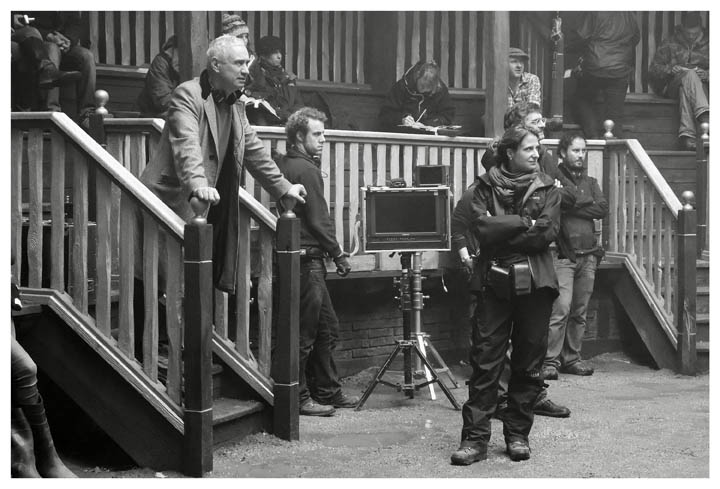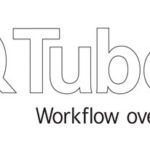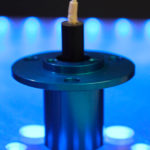
Renaissance Woman: Anna J Foerster
Posted on Aug 16, 2011 by Alex Fice
Rhys Ifans in Anonymous. Words from Simon WakelinAnna J Foerster has made a name for herself as a cinematographer in high demand, lensing big budget Hollywood features while also directing Prime Time television shows such as Criminal Minds on CBS.
Her eclectic skill-set includes aerial photography, underwater photography, visual effects cinematography, blue screen/green screen work plus first unit cinematographer on a host of features including the hotly anticipated Anonymous, an intriguing period piece questioning whether Edward De Vere, the Earl of Oxford actually penned Shakespeare’s own work. The film is about to be released by Sony Pictures this Autumn.
It all began for Foerster when her babysitter shot a student film in her very own back garden. She watched the process unfold and instantly fell in love with the camera.
 Anna with Anonymous director Roland Emmerich“I was 15 at the time and the experience inspired me to become a cinematographer,” she recalls. “My parents even wrote me sick notes to skip school. They allowed me the opportunity to learn about the craft hands on as long as I promised to finish my studies.”
Anna with Anonymous director Roland Emmerich“I was 15 at the time and the experience inspired me to become a cinematographer,” she recalls. “My parents even wrote me sick notes to skip school. They allowed me the opportunity to learn about the craft hands on as long as I promised to finish my studies.”
Foerster began as a loader and clapper on small features and commercials in Germany, working her way up the ladder to become an AC. She then attended Film Academy in Ludwigsburg.
“It was the first year they offered camera studies,” she recalls. “I was driven by the idea of working behind the camera, but never finished my studies because I found myself working a great deal specialising in miniature shooting.”
Foerster was introduced to director Roland Emmerich at the time, a meeting that would prove fruitful. She soon found herself working with Emmerich in America as the VFX director of photography on Independence Day shooting spectacular miniature effects (such as the famous scene of the White House exploding) with the 35mm Photosonics camera system.
 The team in Shakespeare’s Globe Theatre on London’s South BankFoerster also found herself adapting to the work ethics of a foreign industry, something she found difficult to adjust to at the time.
The team in Shakespeare’s Globe Theatre on London’s South BankFoerster also found herself adapting to the work ethics of a foreign industry, something she found difficult to adjust to at the time.
“You can’t compare shooting in the US with Germany,” she notes. “My English was not so good, plus I found myself working in a Union-driven industry. I had absolutely no concept of it at the time, but people pointed me in the right direction explaining why I shouldn’t touch filters and lights and such on set, why it was somebody else’s responsibility. It was such a foreign concept to me back then.”
Foerster continued to shoot Stateside on a number of heavy visual effects shows after the film wrapped. She recalls how much work was shot in-camera at the time, but as digital technology improved so did the rise of blue-and-green screen work that eventually lead her away from the craft.
“It just didn’t satisfy me anymore,” she admits. “Sure, you still needed to sculpt with light but the craft became less about my skills. I became less in charge of creating the overall image, but it also coincided with a desire to be a real part of the storytelling process, a real craving to work first unit.”
Experience
Foerster began DP’ing projects as 2nd Unit Director and Director of Photography on movies including The Day After Tomorrow, 10,000 BC and Aeon Flux. “As the 2nd Unit director you often get handed the stuff that is too time consuming, messy or uncomfortable for 1st Unit, like shooting in below 20 degrees, or in a water pit full of rats,” she notes. “It was difficult but fun.”
She also found scenes with principal actors demanding in her dual role, soon recognising the important of communicating with the talent. She took workshops to acquire more knowledge on acting, soon developing a shorthand that allowed her to work quickly and effective on set:
“You have a huge responsibility as a director to be there for your actors,” she explains. “There are many elements that come into play; the story you want to tell, the movement with the actors. You need to be there, be focused because it is not fair to the actors to leave it up to them to deliver. You can’t just leave it in the hands of the actors to deliver. They deserve your input, your vision and your voice. It’s what makes the magic happen.”
Foerster’s work on Criminal Minds commenced soon after, effectively moving her into the television world. The show initially used 35mm film in her first year directing then switched over to HD with the full sensor Sony F35 system. The new season will go one step further with the introduction of the Red EPIC camera.
Being a new director on a hit television show was a challenging experience for her. “It was a little intimidating at first because I knew nothing about television,” she says. “People told me the pace of shooting was fast compared to features and that I’d never be able to keep up. I took that a bit personally, but soon started to prove them wrong.”
She also notes the importance of having a precise plan of attack to squeeze out script pages at a rapid rate:
“You need to be fast on your feet and make decisions on the fly,” she says. “You have to stay on schedule and you can’t fall behind, otherwise you won’t be there for the next season. But it’s also good to know that you can shoot a lot of pages under pressure, especially of you need to cut your losses. You need a list of what your priorities are in your head, and if things don’t go as planned you need to know exactly what you can let go. Directing an episode can feel like a boot camp. It is very demanding and fast-paced, but when you come out the other end you are stronger. I love that about television.”
Foerster works closely with cinematographer Greg St Johns on the show and enjoys the collaboration. Yet how exactly does it feel to direct without following the action from behind a viewfinder?
“It was a questionable thing for me at first because, obviously, I have an affinity to what I want visually,” she says. “Sometimes I am very particular about where the camera will be placed in a scene, and what lenses will be used. But a cinematographer working on TV brings so much to the table. [Greg] helps you get what you need. I love to collaborate with people like him who care about the story, especially when you have 10 people in a room to cover and you have to move fast.”
Her collaboration with Roland Emmerich also continues this year with the aforementioed Anonymous where Foerster worked as first unit DP. It’s a political thriller positing the theory that it was, in fact, Edward De Vere, the Earl of Oxford who penned all of Shakespeare’s plays. The film is set against the backdrop of the succession of Queen Elizabeth I and the ensuing Essex Rebellion against her.
Foerster worked closely with Emmerich to establish the look of late 16th Century England using the Arri Alexa camera with natural light to recreate the exact lighting conditions of the period.
“The Alexa really is a beautiful camera and it worked well for us,” she notes, shooting at 800 ISO and occasionally pushing to 1280 ISO. “This a dark movie, a dark story so we didn’t want bright, colourful, sun-flooded footage that you often see depicting the era. Daylight, candles and fire were our main light sources. We sometimes used candles right next to the camera to augment lighting in a scene. I never used diffusion filters because the candles and the bright windows would show a slight halo in the image and give the filter away.”
Arri provided a prototype version of the Alexa for the project. It was an eye opening experience for Foerster and she takes her hat off to Arri for allowing the production to use their system before it was publicly released.
“Arri made the camera ready for the shoot and gave us an immense amount of support,” she says. “We really took a risk and I’m absolutely amazed by the camera.”
Foerster shot test footage with different lenses to compare master primes with the Zeiss LWZ.2 Lightweight 15.5-45mm T2.6 Zoom. “I went to Arri in Berlin and put up footage on a projector comparing the different lenses and I loved the look of the zoom,” she explains. “Plus the zoom really sped up the process. We shot a lot of wide footage at 16.5mm, and often went to the 21mm and 25mm length. Very rarely did we go for anything longer than a 40mm. I did have a 12:1 zoom handy just in case, but I rarely used it.”
An interesting element used during the 64-day shoot was immense amounts of smoke. Foerster admits it was rather difficult to see everything on set with the human eye, but once contrast was raised in the RAW image it effectively cut right through the smoke:
“You feel the smoke present in the image, but it was nowhere near as thick it was in real life.” She says. “It worked well to make the image far less pure and clean, a much better method than filters. This is a very dark movie and we pushed the boundaries quite extensively. It takes courage to shoot on digital in this manner, but you know exactly where you are because you work from an exact technical curve that informs you, in the moment, of precisely where you are visually. It allows you to be courageous with your exposure.”
HD workflow was something she also appreciated during the extensive shoot, watching dailies of her work on the same day of shooting.
“Sometimes it’s a bit overwhelming to see images come back at you so quickly, but it does speed up the production process because you end up approving things quickly instead of waiting for a 35mm negative report,” says Foerster. “Now dailies are almost instantaneous.
“I remember asking Dean Semler why he liked using the Panavision Genesis so much. He said it was better for the heart, meaning no stress waiting for dailies and beating yourself up wondering if you’ve got the shot. I have to admit digital has taken a lot of the stress out of the equation.”
Anonymous marks yet another feature for Foerster aside director Roland Emmerich:
“I have worked in many different capacities with him over the years,” she says. “I have learned more about the craft and really understand his ways of thinking. It has been a very organic way of working together. Anonymous was a very close and intense collaboration that I really enjoyed.”
With new episodes to direct in the next season of Criminal Minds, Foerster looks forward to the continued benefits of shooting in HD:
“It’s really helpful that we don’t feel the necessity to cut after each take, and sometimes you just keep the camera rolling and reset quickly to allow the actors to explore the scene,” she says. “Reslating and reloading with film mean you lose a lot of energy on set.”
“I remember shooting helicopter footage on 35mm for 10,000 BC. We were in the middle of nowhere in New Zealand amongst the high peaks with glaciers and snow, so it was always a huge thing to land the chopper, jump out in the snow, then wait for the AC to reload.”
Foerster is currently working on a screenplay in development with Centropolis Entertainment that is moving forward. It’s yet another example of her eclectic skill set, a polymath in Hollywood who revels in her ability to carve out the image in as many different creative mediums as possible:
“What I really like about working as a cinematographer, a director and being involved with screenwriting is that it really opens your eyes to the whole process of filmmaking, and that’s something I love,” says Foerster. “Plus, at the end of the day, it all comes down to storytelling. Each is super good for the other.”
How Arri’s ALEXA Made It To Anonymous
In December 2009, following Camerimage´s screening of the first test footage shot using the IBC sensor demonstrator, Anna contacted ARRI; she was interested in learning more about the high dynamic range and sensitivity of ALEXA. Discussions progressed, and ARRI was invited to test for the show.
Work in progress at that time within the Munich R+D team was at an incomprehensibly complex level – mechanical and electrical camera integration, validation of the camera thermal design concept, and a huge software development push to prepare a validation platform for the first basic camera functions. Additionally, a critical sensor revision was required to push the dynamic range higher and correct the faults found with the IBC sensor demonstrator previewed just four months earlier in Amsterdam.
Initially, the general feeling within ARRI was to decline the invitation to test for Anonymous, but following some late night management reviews and remarkable technical progress during the Christmas and New Year hiatus, ARRI agreed to participate in the test. The stakes were high, but the whole organisation aligned behind the initiative and the test shoot went ahead in February 2010 with the first prototype cameras to be built, the first new Revision B sensors and the first prototype software. ALEXA went head-to-head against the RED ONE MX camera, which we learned later had already been pre-selected for the show. ALEXA came out on top in the tests and ARRI was invited to supply cameras for production.
Production shooting for Anonymous started late in March 2010 with four freshly built prototype ALEXAs, including one backup. The backup camera was only used once during the show, for a two-week period towards the end of the shoot when all four cameras were needed to capture staged scenes with hundreds of extras on the Globe Theatre set.
During the entire three month shoot ARRI held its breath every day, but the cameras delivered the image quality and reliability, the R+D team refined the software, adding new functionality, and the ARRI manufacturing team prepared to enter serial production. Everyone at ARRI learned from the experience and poured all that knowledge back into the program.
Anonymous wrapped on June 10th and that same day the first seven production ALEXA cameras were shipped to Martin Scorsese’s Hugo, which was in prep to shoot 3D with Pace at Shepperton Studios in London.
Neil Fanthom, ARRI













